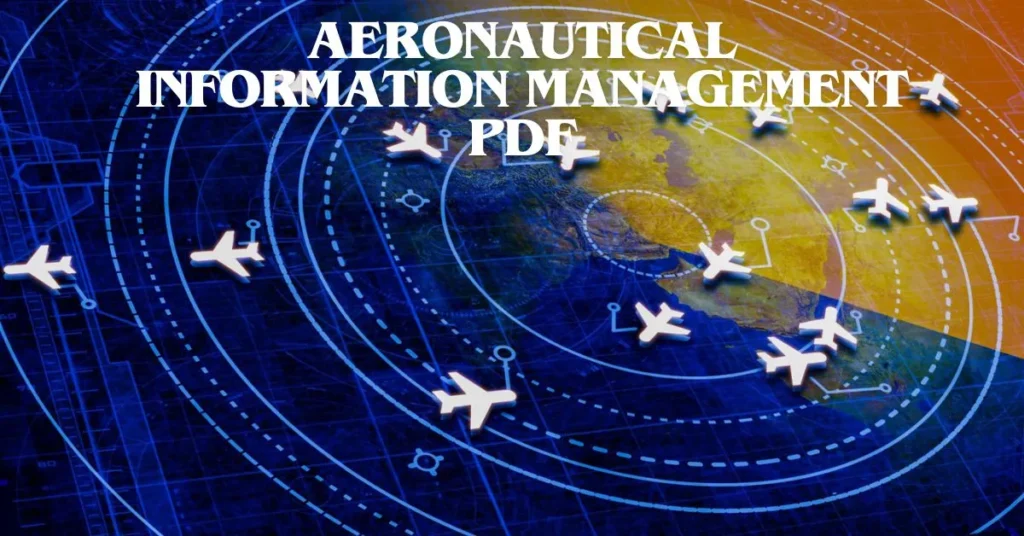In today’s fast-paced aviation world, having accurate and up-to-date information is crucial. This is where aeronautical information management comes into play. If you’ve ever come across an aeronautical information management PDF, you might wonder what it entails and why it’s so important. Let’s dive into the world of aeronautical information management and see how it keeps our skies safe and efficient.
What is Aeronautical Information Management?
Aeronautical information management (AIM) is the practice of managing data that is essential for the safe and efficient movement of aircraft. This includes everything from navigation charts and weather information to NOTAMs (Notices to Airmen) and airspace restrictions. AIM ensures that pilots, air traffic controllers, and other aviation professionals have the information they need to make informed decisions.
The Evolution of AIM:
Traditionally, aeronautical information was managed manually, which was both time-consuming and prone to errors. With the advent of digital technology, AIM has evolved significantly. Today, information is often stored and shared electronically, making it easier to access and update. The aeronautical information management PDF is a prime example of how digital formats have revolutionized the way this data is handled.
The Role of Technology:
Technology plays a pivotal role in modern AIM. Advanced software systems, databases, and digital communication tools have streamlined the process of managing aeronautical information. This has led to greater accuracy, faster updates, and improved safety. For instance, electronic flight bags (EFBs) used by pilots can now store and display AIM data, reducing the reliance on paper documents.
Why Aeronautical Information Management Matters?
You might wonder why aeronautical information management is so critical. The answer lies in the complex and dynamic nature of aviation. Every flight involves numerous variables, from weather conditions to air traffic and navigational aids. AIM helps manage these variables by providing accurate and timely information.
Ensuring Safety:
Safety is the top priority in aviation, and AIM plays a crucial role in maintaining it. Accurate aeronautical information helps pilots navigate safely, avoid hazards, and comply with regulations. For example, if a runway is closed for maintenance, a timely NOTAM ensures that pilots are aware and can plan accordingly. Without reliable AIM, the risk of accidents and incidents would increase significantly.
Enhancing Efficiency:
In addition to safety, AIM also enhances the efficiency of flight operations. By providing real-time data on weather conditions, air traffic, and other factors, AIM helps pilots optimize their flight plans. This can lead to reduced fuel consumption, shorter flight times, and fewer delays. For airlines, this translates to cost savings and improved service for passengers.
The Importance of Aeronautical Information Management PDFs:
With the digital age, the aeronautical information management PDF has become a vital tool for disseminating information. These PDFs contain comprehensive data that is easily accessible and can be quickly updated and shared.
Accessibility and Convenience:
One of the main advantages of using PDFs for AIM is their accessibility. Pilots, air traffic controllers, and other aviation professionals can easily download and view these documents on various devices, including laptops, tablets, and smartphones. This makes it convenient to access critical information anytime, anywhere.
Standardization:
Aeronautical information management PDFs help standardize the presentation of information. This ensures that data is presented consistently, regardless of the source. Standardization is essential in aviation, where clear and unambiguous communication is crucial. By using a consistent format, AIM PDFs help reduce the risk of misinterpretation and errors.
Creating Effective AIM PDFs:
To create effective aeronautical information management PDFs, certain best practices should be followed. These practices ensure that the information is accurate, clear, and user-friendly.
Clear and Concise Information:
When creating AIM PDFs, it’s important to present information clearly and concisely. Avoid unnecessary jargon and use straightforward language. For example, instead of using technical terms, explain concepts in simple terms that can be easily understood by all users. Clear headings, bullet points, and tables can also help organize the information and make it more readable.
Regular Updates:
Aeronautical information is constantly changing, so it’s crucial to keep AIM PDFs up-to-date. Regular updates ensure that users have the most current information. This might involve updating navigation charts, adding new NOTAMs, or revising weather forecasts. Timeliness is key in AIM, as outdated information can compromise safety and efficiency.
Visual Aids:
Including visual aids such as maps, charts, and diagrams can enhance the usability of AIM PDFs. Visual aids help users quickly understand complex information and make better decisions. For instance, a map showing weather patterns can help pilots plan their routes more effectively. When using visual aids, ensure they are clear and appropriately labeled.
The Future of Aeronautical Information Management:
The field of aeronautical information management is continuously evolving, driven by advancements in technology and changes in the aviation industry. Looking ahead, we can expect several trends to shape the future of AIM.
Integration with Advanced Technologies:
One significant trend is the integration of AIM with advanced technologies such as artificial intelligence (AI) and big data analytics. These technologies can help process vast amounts of aeronautical data more efficiently, providing deeper insights and improving decision-making. For example, AI algorithms can analyze weather data to predict turbulence more accurately, helping pilots avoid rough patches during flights.
Enhanced Data Sharing:
Another trend is the enhancement of data sharing among aviation stakeholders. Improved connectivity and communication systems enable real-time sharing of aeronautical information across different platforms. This collaborative approach ensures that all parties have access to the same accurate and timely information, enhancing overall safety and efficiency.
Challenges in Aeronautical Information Management:
Despite the many benefits, managing aeronautical information also comes with its challenges. Understanding these challenges can help in developing better solutions and improving AIM processes.
Data Accuracy and Integrity:
One of the primary challenges in AIM is ensuring the accuracy and integrity of the data. Given the critical nature of aeronautical information, even minor errors can have serious consequences. Therefore, robust quality control measures are necessary to verify and validate the data before it is disseminated.
Keeping Up with Changes:
The dynamic nature of aviation means that aeronautical information is constantly changing. Keeping up with these changes and ensuring that all stakeholders are informed in a timely manner is a significant challenge. This requires efficient communication systems and a proactive approach to information management.
Conclusion:
Aeronautical information management PDFs play a vital role in modern aviation. They provide a convenient and standardized way to disseminate critical information, enhancing both safety and efficiency. As technology continues to evolve, we can expect further improvements in AIM, making our skies safer and more efficient. By understanding the importance of AIM and following best practices in creating AIM PDFs, we can contribute to a safer and more efficient aviation industry. Whether you’re a pilot, air traffic controller, or aviation enthusiast, appreciating the value of aeronautical information management is essential. So next time you come across an AIM PDF, take a moment to appreciate the intricate system that keeps our skies safe and our flights on course.







